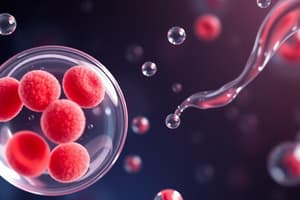Podcast
Questions and Answers
What percentage of total body water is made up of intracellular fluid (ICF)?
What percentage of total body water is made up of intracellular fluid (ICF)?
- 67% (correct)
- 50%
- 75%
- 26%
Which component is NOT found in blood?
Which component is NOT found in blood?
- Red blood cells
- Platelets
- Plasma
- Nerve cells (correct)
What is the primary function of coelomic fluid in some invertebrates?
What is the primary function of coelomic fluid in some invertebrates?
- Temperature regulation
- Nutrient absorption
- Waste storage
- Support and structure (correct)
Which of the following is NOT considered a transport fluid?
Which of the following is NOT considered a transport fluid?
Which fluid bathes tissues and collects waste products and immune cells?
Which fluid bathes tissues and collects waste products and immune cells?
What role does cerebrospinal fluid play?
What role does cerebrospinal fluid play?
What type of fluids are produced by organs and glands to perform specific functions?
What type of fluids are produced by organs and glands to perform specific functions?
Which of the following is NOT a function of coelomic fluid?
Which of the following is NOT a function of coelomic fluid?
What is one primary role of coelomic fluid in invertebrates?
What is one primary role of coelomic fluid in invertebrates?
Which of the following is a key function of lymph in the body?
Which of the following is a key function of lymph in the body?
How does coelomic fluid vary among different animal groups?
How does coelomic fluid vary among different animal groups?
What type of protoplasmic streaming is characterized by cytoplasm flowing in a circular pattern?
What type of protoplasmic streaming is characterized by cytoplasm flowing in a circular pattern?
What is the primary difference between coelomic fluid in invertebrates and vertebrates?
What is the primary difference between coelomic fluid in invertebrates and vertebrates?
Which of the following organisms primarily exhibit open circulatory systems?
Which of the following organisms primarily exhibit open circulatory systems?
Which component is NOT typically found in lymph?
Which component is NOT typically found in lymph?
Why is fat absorption an important function of lymph?
Why is fat absorption an important function of lymph?
What is a primary disadvantage of an open circulatory system?
What is a primary disadvantage of an open circulatory system?
What type of protoplasmic streaming allows organelles to move in opposite directions along specific tracks?
What type of protoplasmic streaming allows organelles to move in opposite directions along specific tracks?
What role do lymph nodes play in the lymphatic system?
What role do lymph nodes play in the lymphatic system?
In which type of circulatory system does blood flow through vessels?
In which type of circulatory system does blood flow through vessels?
What mechanism helps move lymph through the lymphatic system?
What mechanism helps move lymph through the lymphatic system?
Why is protoplasmic streaming essential for cells?
Why is protoplasmic streaming essential for cells?
Which of the following statements is true regarding gas exchange in an open circulatory system?
Which of the following statements is true regarding gas exchange in an open circulatory system?
What type of organism is likely to have high activity levels and needs for efficient circulation?
What type of organism is likely to have high activity levels and needs for efficient circulation?
What primary role do red blood cells (RBCs) serve in the body?
What primary role do red blood cells (RBCs) serve in the body?
Which component of blood is primarily responsible for transporting hormones?
Which component of blood is primarily responsible for transporting hormones?
How does chronic stress affect lymphatic health?
How does chronic stress affect lymphatic health?
Which nutrient, when included in the diet, supports immune function?
Which nutrient, when included in the diet, supports immune function?
What is the function of platelets in the blood?
What is the function of platelets in the blood?
What is a potential consequence of lymphedema?
What is a potential consequence of lymphedema?
What primary component of blood makes up about 55% of its volume?
What primary component of blood makes up about 55% of its volume?
What is a role of blood in temperature regulation?
What is a role of blood in temperature regulation?
What is the primary purpose of osmoregulation in organisms?
What is the primary purpose of osmoregulation in organisms?
Which of the following best describes how saltwater fish osmoregulate compared to freshwater fish?
Which of the following best describes how saltwater fish osmoregulate compared to freshwater fish?
What role do excretory organs play in osmoregulation?
What role do excretory organs play in osmoregulation?
Which of the following excretory organs is associated with crustaceans?
Which of the following excretory organs is associated with crustaceans?
How do flame cells function in the excretory system of flatworms?
How do flame cells function in the excretory system of flatworms?
What mechanism do organisms use to adjust solute concentrations in response to environmental needs?
What mechanism do organisms use to adjust solute concentrations in response to environmental needs?
Which of the following is NOT a common excretory organ for vertebrates?
Which of the following is NOT a common excretory organ for vertebrates?
What is the significance of maintaining the balance of water and solutes in body fluids?
What is the significance of maintaining the balance of water and solutes in body fluids?
Flashcards are hidden until you start studying
Study Notes
Circulation and Types of Circulating Fluid
- Circulating fluids can be categorized by location:
- Intracellular Fluid (ICF): Comprises about 67% of total body water, found inside cells, containing electrolytes, proteins, and nutrients.
- Extracellular Fluid (ECF): Accounts for about 26% of total body water, includes blood and lymph.
Blood
- Blood plays a critical role in transportation:
- Contains plasma (55% of blood volume), which includes water, proteins (albumins, antibodies), electrolytes, hormones, glucose, and waste products.
- Blood Cells: Comprises 45% of blood volume; includes:
- Red Blood Cells (RBCs): Transport oxygen to tissues using hemoglobin.
- White Blood Cells (WBCs): Integral to the immune system, combating infections.
- Platelets: Vital for blood clotting processes.
Lymph and Its Role
- Lymph is vital for fluid balance and immune defense:
- Comprised of clear fluid similar to blood plasma but without red blood cells.
- Contains lymphocytes, fats, waste products, and cell debris.
- Lymphatic system functions:
- Collects excess fluid, preventing swelling.
- Filters pathogens and debris through lymph nodes.
- Transports dietary fats as chylomicrons.
Coelomic Fluid
- Coelomic fluid supports various functions in animals:
- Acts as a hydrostatic skeleton in invertebrates, providing support.
- Facilitates transport of nutrients, gases, and waste in simpler circulatory systems.
- Plays a role in lubrication of internal organs to reduce friction.
- In some species, involved in reproductive processes.
Open and Closed Circulation
-
Open Circulation:
- Found in invertebrates (e.g., insects, mollusks); blood flows freely in body cavities.
- Simple heart pumps hemolymph into sinuses, leading to low pressure and less efficient circulation.
- Specialized organs handle gas exchange and waste removal directly with the environment.
-
Closed Circulation:
- Present in vertebrates (e.g., humans, fish); blood travels through a network of vessels.
- Provides more efficient transport of oxygen and nutrients over longer distances compared to open systems.
Osmoregulation
- Essential for maintaining the osmotic balance of body fluids, composed primarily of water (60% of body).
- Organisms adjust solute concentrations and membrane permeability to regulate fluids.
- Different strategies include excreting excess solutes and waste' crucial for preventing toxic buildup.
Excretory Organs in Animals
-
Specialized organs remove metabolic waste:
- Invertebrates:
- Flame cells (flatworms): Filter waste using cilia.
- Nephridia (earthworms): Filter blood waste through excretory pores.
- Malpighian tubules (insects): Absorb waste from hemolymph and release into the digestive tract.
- Green glands (crustaceans): Filter blood waste through ducts.
- Invertebrates:
-
Vertebrates:
- Kidneys: Main organs for filtering blood, eliminating waste and producing urine.
Studying That Suits You
Use AI to generate personalized quizzes and flashcards to suit your learning preferences.





